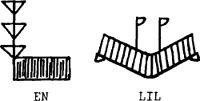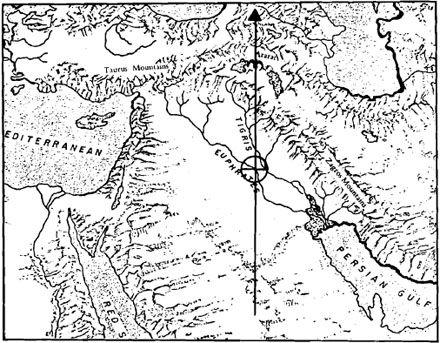The 12th Planet (47 page)
Authors: Zecharia Sitchin
Tags: #Non-Fiction, #Gnostic Dementia, #Fringe Science, #Retail, #Archaeology, #Ancient Aliens, #History

In the center of Nippur, atop an artificially raised platform, stood Enlil's headquarters, the KI.UR ("place of Earth's root")—the place where the "bond between Heaven and Earth" rose. This was the communications center of Mission Control, the place from which the Anunnaki on Earth communicated with their comrades, the IGI.GI ("they who turn and see") in the orbiting spacecraft.
At this center, the ancient text goes on to say, stood a "heavenward tall pillar reaching to the sky." This extremely tall "pillar," firmly planted on the ground "as a platform that cannot be overturned," was used by Enlil to "pronounce his word" heavenward. This is a simple description of a broadcasting tower. Once the "word of Enlil"—his command—"approached heaven, abundance would pour down on Earth." What a simple way to describe the flow of materials, special foods, medicines, and tools brought down by the shuttlecraft, once the "word" from Nippur was given!
This Control Center on a raised platform, Enlil's "lofty house," contained a mysterious chamber, named the DIR.GA:
As mysterious as the distant Waters,
as the Heavenly Zenith.
Among its ... emblems,
the emblems of the stars.
The ME it carries to perfection.
Its words are for utterance....
Its words are gracious oracles.
What was this
dirga?
Breaks in the ancient tablet have robbed us of more data; but the name speaks for itself, for it means "the dark, crownlike chamber," a place where star charts were kept, where predictions were made, where the
me
(the astronaut's communications) were received and transmitted. The description reminds us of Mission Control in Houston, Texas, monitoring the astronauts on their Moon missions, amplifying their communications, plotting their courses against the starry sky, giving them "gracious oracles" of guidance.
We may recall here the tale of the god Zu, who made his way to Enlil's sanctuary and snatched away the Tablet of Destinies, where-upon "suspended was the issuance of commands... the hallowed inner chamber lost its brilliance... stillness spread... silence prevailed."
In the "Epic of Creation," the "destinies" of the planetary gods were their orbits. It is reasonable to assume that the Tablet of Destinies, which was so vital to the functions of Enlil's "Mission Control Center," also controlled the orbits and flight paths of the spaceships that maintained the "bond" between Heaven and Earth. It might have been the vital "black box" containing the computer programs that guided the spaceships, without which the contact between the Nefilim on Earth and their link to the Home Planet was disrupted.
Most scholars take the name EN.LIL to mean "lord of the wind," which fits the theory that the ancients "personified" the elements of nature and thus assigned one god to be in charge of winds and storms. Yet some scholars have already suggested that in this instance the term LIL means not a stormy wind of nature but the "wind" that comes out of the mouth—an utterance, a command, a spoken communication. Once again, the archaic Sumerian pictographs for the term EN—especially as applied to Enlil—and for the term LIL, shed light on the subject. For what we see is a structure with a high tower of antennas rising from it, as well as a contraption that looks very much like the giant radar nets erected nowadays for capturing and emitting signals—the "vast net" described in the texts. (Fig. 129)
In Bad-Tibira, established as an industrial center, Enlil installed his son Nannar/Sin in command; the texts speak of him in the list of cities as NU.GIG ("he of the night sky"). There, we believe, the twins Inanna/lshtar and Utu/Shamash were born—an event marked by associating their father Nannar with the next zodiacal constellation, Gemini (the Twins). As the god trained in rocketry, Shamash was assigned the constellation GIR (meaning both "rocket" and "the crab's claw," or Cancer), followed by Ishtar and the Lion (Leo), upon whose back she was traditionally depicted.

Fig. 129
The sister of Enlil and Enki, "the nurse" Nin
h
ursag (SUD), was not neglected: In her charge Enlil put Shuruppak, the medical center of the Nefilim—an event marked by naming her constellation "The Maid" (Virgo).
While these centers were being established, the completion of Nippur was followed by the construction of the spaceport of the Nefilim on Earth. The texts made clear that Nippur was the place where the "words"—commands-were uttered: There, when "Enlil commanded: 'Towards heaven!' ... that which shines forth rose like a sky rocket." But the action itself took place "where Shamash rises," and that place—the "Cape Kennedy" of the Nefilim—was Sippar, the city in the charge of the Chief of the Eagles, where multistage rockets were raised within its special enclave, the "sacred precinct."
As Shamash matured to take command of the Fiery Rockets, and in time also to become the God of Justice, he was assigned the constellations Scorpio and Libra (the Scales).
Completing the list of the first seven Cities of the Gods and the correspondence with the twelve zodiac constellations was Larak, where Enlil put his son Ninurta in command. The city lists call him PA.BlL.SAG ("great protector"); it is the same name by which the constellation Sagittarius was called.
•
It would be unrealistic to assume that the first seven Cities of the Gods were established haphazardly. These "gods," who were capable of space travel, located the first settlements in accordance with a definite plan, serving a vital need: to be able to land on Earth and to leave Earth for their own planet.
What was the master plan?
As we searched for an answer, we asked ourselves a question: What is the origin of Earth's astronomical and astrological symbol, a circle bisected by a right-angled cross—the symbol we use to signify "target"?
The symbol goes back to the origins of astronomy and astrology in Sumer and is identical with the Egyptian hieroglyphic sign for "place":

Is this coincidence, or significant evidence? Did the Nefilim land on Earth by superimposing on its image or map some kind of "target"?
The Nefilim were strangers to Earth. As they scanned its surface from space, they must have paid special attention to the mountains and mountain ranges. These could present hazards during landings and takeoffs, but they could also serve as navigational landmarks.
If the Nefilim, as they hovered over the Indian Ocean, looked toward the Land Between the Rivers, which they had selected for their earliest colonizing efforts, one landmark stood out unchallenged: Mount Ararat.
An extinct volcanic massif, Ararat dominates the Armenian plateau where the present-day borders of Turkey, Iran, and Soviet Armenia meet. It rises on the eastern and northern sides to some 3,000 feet above sea level, and on the northwestern side to 5,000 feet. The whole massif is some twenty-five miles in diameter, a towering dome sticking out from the surface of Earth.
Other features make it stand out not only from the horizon but also from high in the skies. First, it is located almost midway between two lakes, Lake Van and Lake So-Van. Second, two peaks rise from the high massif: Little Ararat (12,900 feet) and Great Ararat (17,000 feet—well over 5 kilometers). No other mountains rival the solitary heights of the two peaks, which are permanently snow-covered. They are like two shining beacons between the two lakes that, in daylight, act as giant reflectors.
We have reason to believe that the Nefilim selected their landing site by coordinating a north–south meridian with an unmistakable landmark and a convenient river location. North of Mesopotamia, the easily identifiable twin-peaked Ararat would have been the obvious landmark. A meridian drawn through the center of the twin-peaked Ararat bisected the Euphrates. That was the target—the site selected for the spaceport. (Fig. 130)
Could one easily land and take off there?
The answer was Yes. The selected site lay in a plain; the mountain ranges surrounding Mesopotamia were a substantial distance away. The highest ones (to the east, northeast, and north) would not interfere with a space shuttle gliding in from the southeast.

Fig. 130
Was the place accessible—could astronauts and materials be brought there without too much difficulty?
Again, the answer was Yes. The site could be reached overland and, via the Euphrates River, by waterborne craft.
And one more crucial question: Was there a nearby source of energy, of fuel for light and power? The answer was an emphatic Yes. The bend in the Euphrates River where Sippar was to be established was one of the richest known sources in antiquity of surface bitumens, petroleum products that seeped up through natural wells and could be collected from the surface without any deep digging or drilling.
We can imagine Enlil, surrounded by his lieutenants at the spacecraft's command post, drawing the cross within a circle on the map. "What shall we call the place?" he may have asked.
"Why not 'Sippar'?" someone might have suggested.
In Near Eastern languages, the name means "bird." Sippar was the place where the Eagles would come to nest.
How would the space shuttles glide down to Sippar?
We can visualize one of the space navigators pointing out the best route. On the left they had the Euphrates and the mountainous plateau west of it; on the right, the Tigris and the Zagros range east of it. If the craft were to approach Sippar at the easily set angle of 45 degrees to the Ararat meridian, its path would take it safely between these two hazardous areas. Moreover, coming in to land at such an angle, it would cross in the south over the rocky tip of Arabia while at a high altitude, and start its glide over the waters of the Persian Gulf. Coming and going, the craft would have an unobstructed field of vision and of communication with Mission Control at Nippur.
